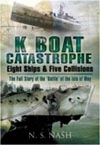The First ASW Patrol
After some repairs and alterations in Norfolk, supplies were loaded and preparations for departure completed.
Task Group 21.12 (USS Guadalcanal - flagship, accompanied by the DDs Alden, John D. Edwards, Whipple, and John D. Ford) departed Hampton Roads 5 January 1944 bound for the Cape Verde Islands. The veteran VC-13 squadron commanded by Lt. Cdr. Adrian H. Perry was aboard with 21 aircraft; 9 FM-1 Wildcats and 12 TBF-1c Avengers. Tenth Fleet had located a U-boat re-fueling area 500 miles west of the Azores and TG 21.12 headed for that location.
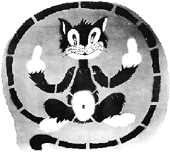 Left: VC-13 Squadron Insignia
Left: VC-13 Squadron Insignia
Heavy seas were immediately encountered and at 2013 the evening of departure a lookout was washed overboard. Search operations were conducted but the man was never found. Flight operations were extremely difficult in the heavy weather and two Wildcats were so badly damaged they were put ashore in Bermuda three days later. The bad weather continued and on 10 January Lt.(jg) James Schoby's Avenger, attempting to land, bounced over the side of the pitching ship. Only the ball turret gunner was saved. Schoby had received the DFC for his part in the sinking of U-487 in July 1943.
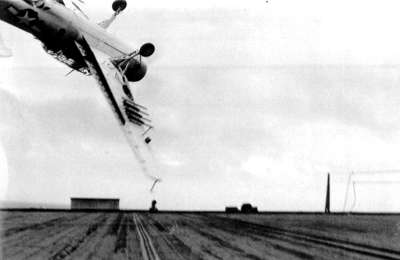
Lt.(jg) Schoby's TBF goes over the side
Two hours later another Avenger landed in the catwalk, fouling the deck, and an Avenger still in the air and out of fuel was forced to ditch.
The Sinking of U-544
On the afternoon of 16 January, Ensigns Bert Hudson and William McLane flying Avengers spotted three submarines on the surface. The tanker U-544 was in the process of re-fueling U-516 with U-129 standing by. Upon sighting the aircraft, U-129 dived and disappeared. U-544 and U-516 remained on the surface, the crews struggling to disconnect the fueling lines joining the two boats. Hudson attacked from the starboard beam firing two rocket salvos at a range of 500 to 800 yards. The first two rockets fell short of U-516 but U-544 was hit by the second two. Continuing on his run, Hudson fired his remaining rockets and dropped two MK-47 depth charges. U-544 was again hit by rockets; one depth charge detonated about 50 feet from U-516 and the second exploded between the two U-boats. U-516 was seen to go down slowly by the stern, bow high in the air. Men were seen to be jumping overboard from U-544.
McLane, following Hudson in, fired his rockets in three salvos, dropping two MK-47s as he fired the last two rockets. One Mk-47 detonated too far away to do any damage but the other exploded close by U-544. U-516 had disappeared and was thought to have been sunk. This later proved not to be the case. The damaged U-516 was able to regain control and move out of the area. U-544 went down stern first. When the aircraft departed the scene, twenty to thirty men were seen to be swimming in a huge pool of oil. Two of the destroyers were sent to pick-up survivors but no one was found when they arrived on the scene.
By this time it was getting dark. Guadalcanal had eight planes in the air, which were low on fuel and needed to be recovered. The first four were landed without incident. The next Avenger ended up with both wheels down in the starboard catwalk, tail sticking out partially blocking the flight deck. For the next 10 to 15 minutes the flight deck crew struggled to clear the deck but were unable either to get the plane back up on the flight deck or to push it over the side. It was now pitch black. The returning pilots had reported a fourth submarine in the area but it was decided to risk turning on the carriers flight deck landing lights. The remaining three aircraft still in the air made repeated approaches, all of which were waved off. The tail of the plane in the catwalk projecting out into the flight deck was crowding the landing aircraft too far to port side. Finally one Avenger took a "cut", hit the deck, bounced over the side, and went into the water upside down. All three men were rescued by the plane guard. With that, the destroyers searchlights were turned on to illuminate the sea surface and the last two planes ditched alongside and the crews recovered. The Task Group then headed for Casablanca to re-supply and begin the trip back to Norfolk.
The Avenger in the catwalk was finally pulled back up on the flight deck and thereupon began a long series of exercises on how to get a plane out of the catwalk in short order. For the next several days the flight deck crew would push the plane into the catwalk and then pull it back out again. This exercise was repeated over and over until that crew could extract an Avenger with both wheels in the catwalk in three minutes flat. With that the Captain allowed a dog-tired but jubilant flight deck crew to push the plane, now damaged beyond repair, into the sea.
On the 18th, Edwards reported a sound contact and launched a depth charge attack. Whipple left the screen to assist but no further contacts were gained.
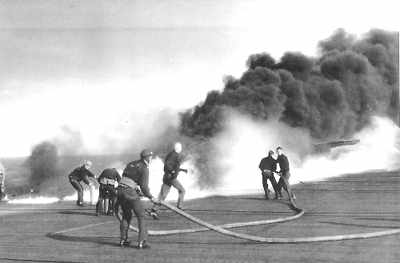
Lt.(jg) Wanton's Wildcat wing tank explodes
A few days later, Lt.(jg) Wanton flying a Wildcat was unable to draw fuel from his external wingtank. Running low on the main tank the pilot had returned to the ship early. Before coming aboard he attempted to drop the tank which only partially released. Informing the ship he would either have to ditch or come aboard immediately, the decision was to bring him aboard with the full wing tank still dangling on the wing. The shock of the arrested landing jarred the tank loose which shattered and hurtled up the deck.
Instantly the Wildcat and half the flight deck were engulfed in flames. Believing they were about to pickup survivors, the escorting DDs moved in to lend assistance. However the flight deck crew manned the firefighting system and put out the fire. Amazingly, the pilot got out of the plane and except for some 1st and 2nd degree burns no one was seriously injured. The only damage to the ship was a charred flight deck and one less Wildcat.
The hard luck continued. On 20 January Lt. (jg) Bert Beattie became lost while on patrol. Unable to communicate with the ship, his Avenger was last seen on the ships radar heading for the Azore Islands. People on Flores later reported seeing a plane land in the sea just offshore and 3 men in the surf who were swept out to sea. The radioman's body was found later but there was no further trace of the pilot and gunner.
Departing Casablanca on 29 Jan after a short stay to refuel, Guadalcanal headed back to Norfolk. So many aircraft had been damaged and lost that operations were considerably reduced. The foul weather continued and several more accidents occurred.
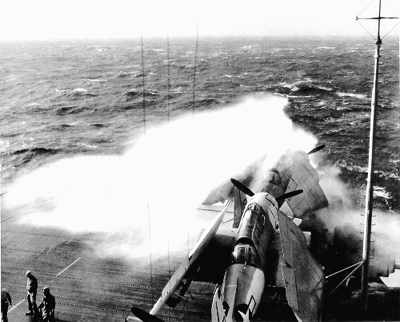
USS Guadalcanal in heavy seas
No U-boats were encountered on the return trip. When Guadalcanal reached Norfolk on 17 February, there were only 3 Avengers and 3 Wildcats left to fly off.
It was a different crew which returned to Norfolk. On the first time out, this crew had experienced almost every problem to be encountered on an escort carrier in the Atlantic, with the exception of getting sunk. Crewman, pilots, and aircraft had been lost. The ship had endured extreme weather and a significant fire. One U-boat had been accounted for and another damaged but the price had been high. But "Can Do's" crew was seasoned and tougher now, and had developed the sense of confidence which comes with mastering adversity. This crew was absolutely determined to make a better showing of it on the next cruise.
USS Guadalcanal
- Chapter 1 - Commissioning USS Guadalcanal
- Chapter 2 - Training for battle
- Chapter 3 - The First ASW Cruise
- Chapter 4 - Night Flying Initialized
- Chapter 5 - The U-505 Episode


